Alberta is the fourth-largest province in Canada and is bordered by British Columbia to the west and Saskatchewan to the east.
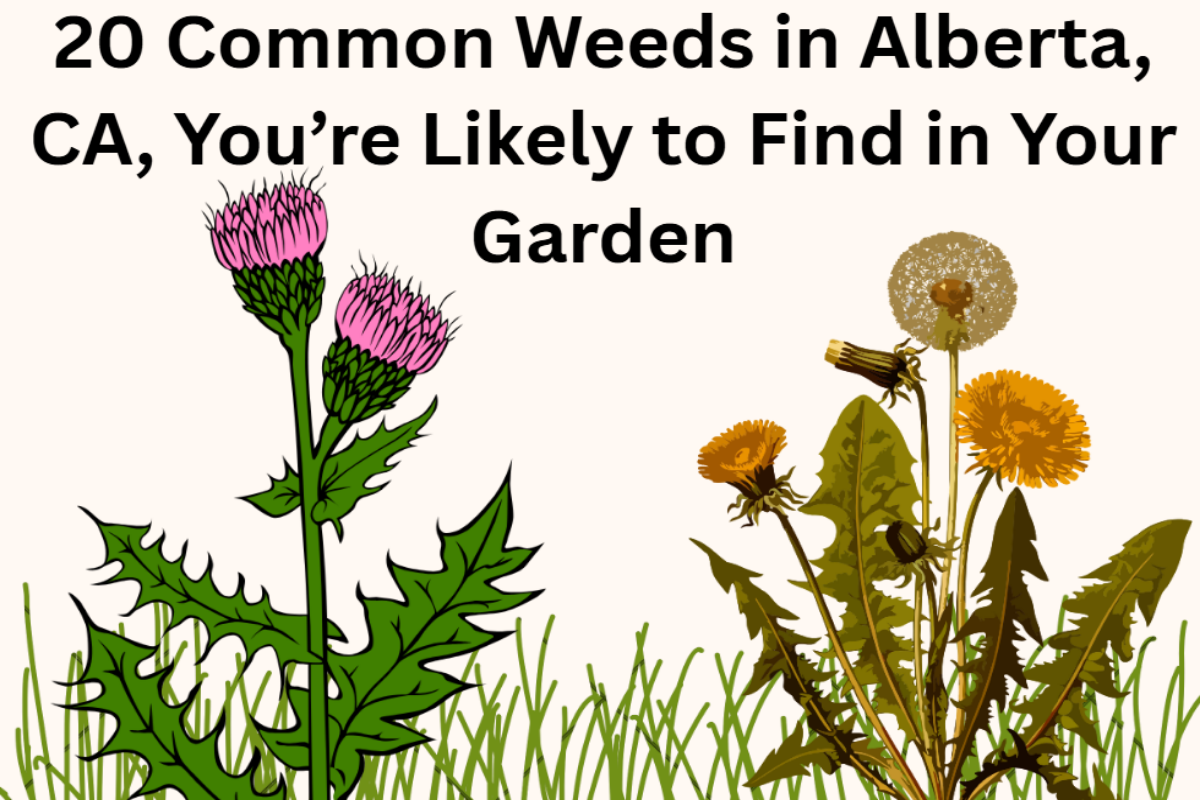
Geographically, it stretches from the Rocky Mountains in the west to the prairies and boreal forests in the east, making it one of Canada’s most diverse regions in terms of landscape.
In terms of climate, this province experiences a continental climate, characterized by warm to hot summers and cold winters. These climatic factors encourage the growth of a wide range of garden weeds.
Additionally, as the sunniest province in Canada with fluctuating moisture levels, Alberta is an ideal environment for persistent and invasive weed species.
This article covers 20 common weeds you’ll find in your outdoor space along with their distinct physical attributes for easy identification. We’ll also recommend the best removal methods to help maintain a healthy, weed‑free garden.
1. White Clover (Trifolium repens)

- Local Name: White Clover
- Family: Fabaceae
- Annual or Perennial: Perennial
White clover is a perennial creeping plant that generally grows 10-15 cm tall. You can identify it by its three-parted leaflets and white clustered flowers that fade to pink with age.
It is native to Europe and Asia, and since it was introduced in Canada, it can be found throughout Alberta in a variety of habitats, including residential gardens and lawns.
T. repens aggressively roots at stem nodes, forming large patches in areas around the garden where other plants will not grow.
There are several ways to eliminate white clover. You can manually remove the young plants, grow a vigorous lawn that outcompetes the weed through increased nitrogen fertilization, or increase mowing height, preferably over 3 inches.
2. Black Medic (Medicago lupulina)
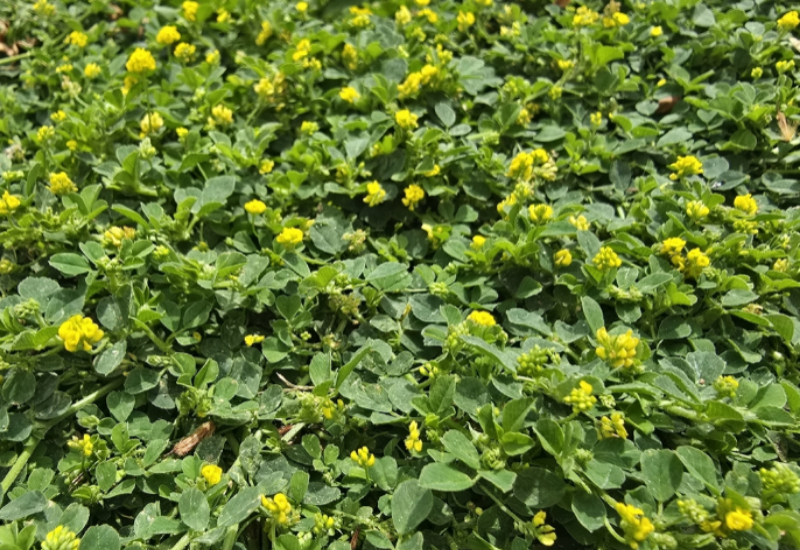
- Local Name: Hop Clover, Black Clover, or Yellow Trefoil
- Family: Fabaceae
- Annual or Perennial: Annual or Short-lived Perennial
Black Medic is a common broadleaf weed in the legume family. It is native to Europe and temperate Asia, but now can be found in many regions across Alberta. You can identify it by its trifoliate leaves and small yellow flowers.
Like White Clover, Black Medic is a strong indicator of low nitrogen levels in your outdoor landscape. It is a prolific seed producer and grows a deep tap root, quickly becoming invasive.
Hand-pulling is a viable option for small infestations. Correct compaction, aerate, seed, or fertilize your soil to prevent Black Medic growth.
3. Dandelion (Taraxacum officinale)

- Local Name: Dandelion
- Family: Asteraceae
- Annual or Perennial: Perennial
Few weeds can scream spring in Alberta like dandelions. Their vigorous growth and bright yellow heads usher in warmer weather after long, cold winters. However, they can also take over gardens, and like other prolific seed-producing weeds, they stick out like a sore thumb.
You can pull them out by hand and make sure to remove the entire taproot to prevent regrowth. Cutting the weeds before they seed using handy tools can also efficiently remove the weeds.
4. Quackgrass (Elymus repens)

- Local Name: Quackgrass or Couch Grass
- Family: Poaceae
- Annual or Perennial: Perennial
Quackgrass is one of the most troublesome weeds in Alberta. The perennial grass can be identified by its linear, light-green leaves and wheat-like spikelets.
As an aggressive weed, it spreads by seeds and rhizomes and establishes deep roots, taking over gardens quickly. It not only competes with other desirable plants but also diminishes the aesthetic appeal of the outdoor spaces.
Remove the clumps of grass by hand or through repeated cultivation. Ensure that you remove the rhizome fragments and dispose of them to prevent regrowth.
5. Purslane (Portulaca oleracea)

- Local Name: Purslane
- Family: Portulacaceae
- Annual or Perennial: Annual
Purslane is a native of Northern Africa and Southern Europe, but has been widely naturalized in Alberta. It is a low-growing succulent weed with reddish stems and flat, rubbery leaves that form dense mats in gardens.
While P. oleracea is adapted to growing in poor soils, you’ll mostly find it in poorly maintained gardens or newly established turf.
Hand-pulling is generally sufficient to remove purslane weeds, as solitary plants tend to cover large areas. Ensure that all leaves and stems are disposed of correctly.
6. Canada Thistle (Cirsium arvense)

- Local Name: Canadian Thistle
- Family: Asteraceae
- Annual or Perennial: Perennial
Canada thistle is an aggressive colony-forming weed that grows up to 1.5 m tall. It is easily identified by its lance-shaped, dark green leaves with spiny margins and clusters of pink to purple flowers.
This noxious weed spreads by seed and creeping roots, quickly overtaking desirable plants and turf in gardens.
Pull or dig deeply to remove roots or mow before seed set to starve the weed of nutrients.
7. Leafy Spurge (Euphorbia esula)

- Local Name: Leafy Spurge
- Family: Euphorbiaceae
- Annual or Perennial: Perennial
A native of Europe and Asia, Leafy Spurge was introduced as an ornamental in Alberta and has since been classified as a noxious weed.
It has clumpy stems, waxy, bluish-green leaves, and small yellowish-green flowers supported by bracts. It forms deep roots (up to 9m) and spreads 4-5m laterally.
For these reasons, eradicating leafy spurge requires patience (as complete eradication may take time) and a multifaceted approach. Consider hand pulling or mowing for small, young plants and continuous, intensive cultivation for larger plants until complete eradication is achieved.
8. Common Mallow (Malva neglecta)

- Local Name: Garden Mallow
- Family: Malvaceae
- Annual or Perennial: Perennial
Common Mallow is a herbaceous perennial, erect or prostrate, about 90 cm tall. It has branched and hairy stems, long-stalked, green to purple leaves, and five-petaled white to pinkish flowers.
While it may provide beautiful blooms for the garden, it can also spread if left unchecked. Digging out the seedlings before they develop woody taproots is the best option. This is achievable before the plant develops four leaves.
9. Creeping Bellflower (Campanula rapunculoides)
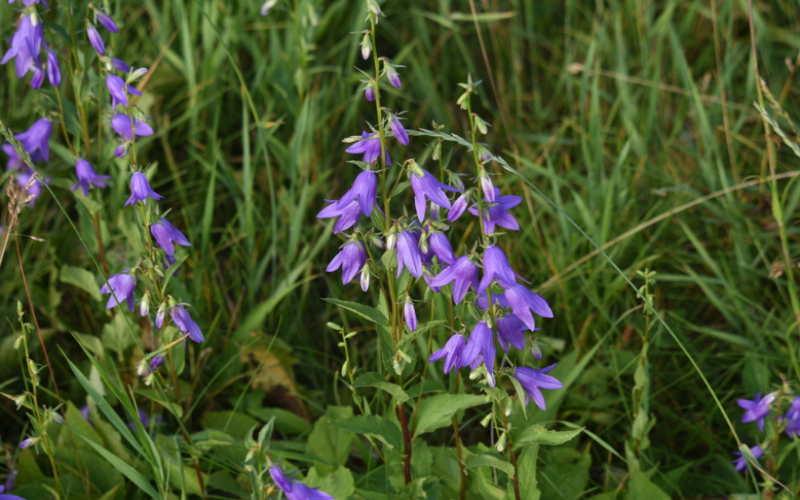
- Local Name: Creeping Bellflower
- Family: Campanulaceae
- Annual or Perennial: Perennial
A common summer garden weed in Alberta, Creeping Bellflower can steal the heart with its bright, bell-shaped, purple flowers. However, it’s an aggressive and invasive plant that tends to take over the entire garden, making it a weed to watch.
To effectively remove it, use your hands or a small garden shovel and ensure you dig out the entire root system to avoid regrowth.
10. Common Chickweed (Stellaria media)
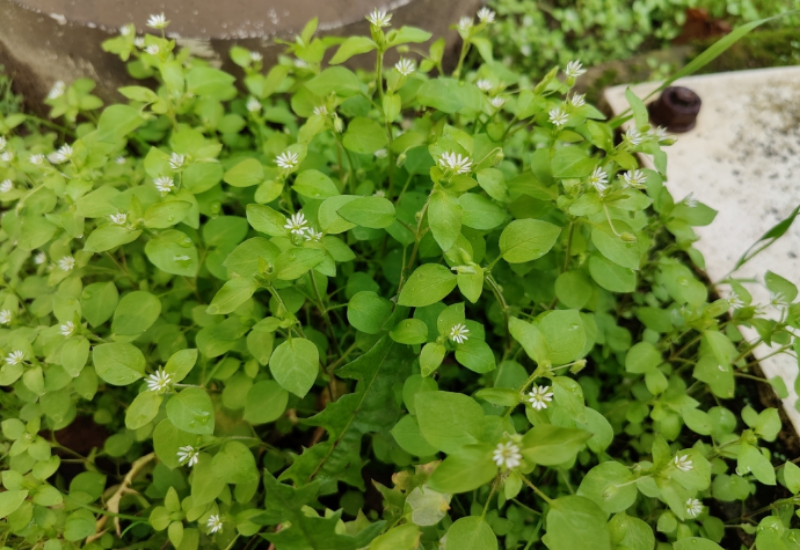
- Local Name: Chickweed, Nodding Chickweed
- Family: Caryophyllaceae
- Annual or Perennial: Annual or Short-lived Perennial
While it may be native to Europe, Asia, and Northern Africa, chickweed has since been introduced in Canada and can now be found throughout Alberta.
You can identify the winter weed by its egg-shaped to elliptic leaves, small, white, star-shaped flowers, and delicate, prostrate stems that form mats on the ground.
Remove the weed by hand-pulling or using a digging tool when the ground is moist, as it has shallow roots, and ensure all seeds and stems are well disposed of to prevent regrowth. Mulching the affected area may also control the weed growth.
11. Yellow Nutsedge (Cyperus esculentus)

- Local Name: Yellow Nutgrass, Chufa Sedge, Tigernut, Grass Nutsedge, or Earth Almond
- Family: Cyperaceae
- Annual or Perennial: Perennial
Yellow Nutsedge is a native weed that you’ll probably find in poorly drained areas in your vegetable or flower garden. The grass-like sedge has yellow-greenish leaf blades and yellow or purple flower heads.
To get rid of the sedge, repeatedly remove the small plants before they develop tubers. Eliminate the wet conditions in your garden by applying a fabric mulch.
12. Tall Buttercup (Ranunculus acris)

- Local Name: Meadow Buttercup, Field Buttercup, or Giant Buttercup
- Family: Ranunculaceae
- Annual or Perennial: Perennial
Tall Buttercup is a perennial plant that grows up to 1 meter tall. The weed has branched stems, deeply lobed leaves, and bright yellow flowers.
It is typically found in meadows and pastures but can also grow in gardens, displacing desirable plants through its efficient seed and rhizome propagation.
Hand-pulling and digging are viable control strategies for small infestations. Mowing and eliminating wet conditions around the garden can also reduce infestations.
13. Annual Bluegrass (Poa annua)

- Local Name: Annual Bluegrass
- Family: Poaceae
- Annual or Perennial: Annual
As the name implies, Bluegrass is an annual grass that is a common and persistent weed in gardens. It is a short-growing grass that competes for resources and also forms dense clumps, overtaking other garden plants.
Pull or dig out the small grass infestations before seed production. Repeat as many times as possible to achieve complete eradication.
14. Common Tansy (Tanacetum vulgare)

- Local Name: Garden Tansy or Golden Buttons
- Family: Asteraceae
- Annual or Perennial: Perennial
Garden Tansy is an Eurasian native that grows 30-150 cm tall. It is easily identified by its clustered stems, alternate fern-like leaves, and golden-yellow button flowers.
The aromatic perennial spreads by seeds and short underground rhizomes, competing for resources and forming dense patches that can reduce aesthetic appeal.
The best removal methods are hand-pulling and mowing before seed set.
15. Purple Loosestrife (Lythrum salicaria)

- Local Name: Purple Loosestrife
- Family: Lythraceae
- Annual or Perennial: Perennial
Purple Loosestrife was once a beloved garden staple for its stunning pink to purple flowers. However, due to its highly invasive nature, it has since been classified as a noxious weed in Alberta and other provinces in Canada.
It forms numerous brushlike stands that compete for resources and can outcompete other vegetation. Look out for wet areas around your garden because once it establishes, it can cause waterlogging by blocking drainage.
Repeated cutting and mowing of the young plants before they set seed will provide effective control.
16. Yellow Toadflax (Linaria vulgaris)
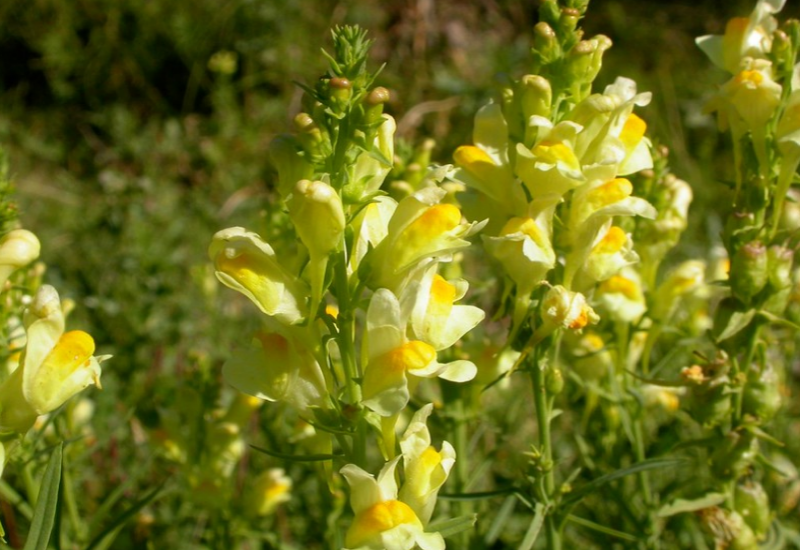
- Local Name: Common Toadflax
- Family: Plantaginaceae
- Annual or Perennial: Perennial
Like many other Eurasian natives, Yellow Toadflax was introduced in Canadian provinces like Alberta as an ornamental and for other economic uses.
While it can provide stunning lance-shaped leaves and showy yellow blooms to brighten your garden, it can easily escape and aggressively take over.
Remove by pulling where applicable or incorporate heavy cultivation to ensure you dig out all the root stalks.
17. Buckhorn Plantain (Plantago lanceolata)
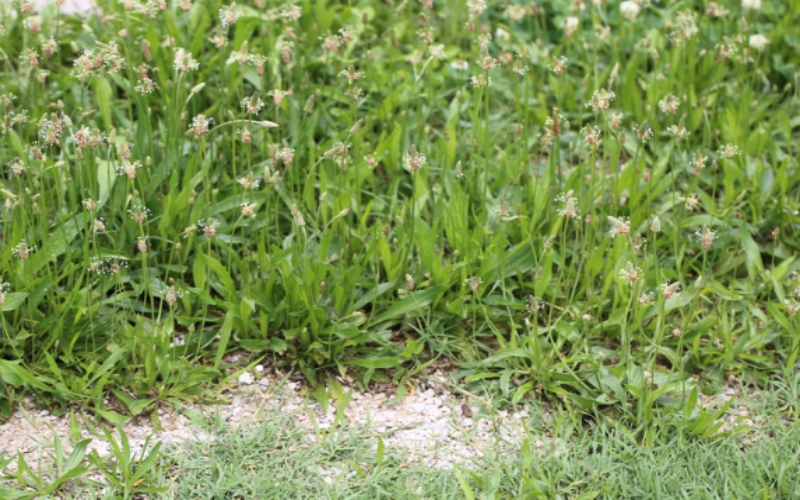
- Local Name: Narrow-leaved Plantain, English Plantain, or Rib Grass
- Family: Plantaginaceae
- Annual or Perennial: Perennial
Buckhorn Plantain is a common garden weed that grows 30- 60 cm tall. It can be identified by its mature, elongated leaves with whitish midveins that form a basal rosette and a dense cluster of inconspicuous flowers on a cylindrical, upright flowerhead.
This weed forms dense patches, quickly overtaking other desirable vegetation. It may also be a strong indicator of areas with low fertility.
Quick removal intervention is vital for this plantain weed. Repeated hand-pulling and digging of the young plants to remove the root system is the best way to eradicate it. Monitor consistently and repeat the control measures as required to prevent regrowth.
Laying a landscape fabric and organic mulch on seedlings can also limit weed growth and spread.
18. Lamb’s Quarter (Chenopodium berlandieri)
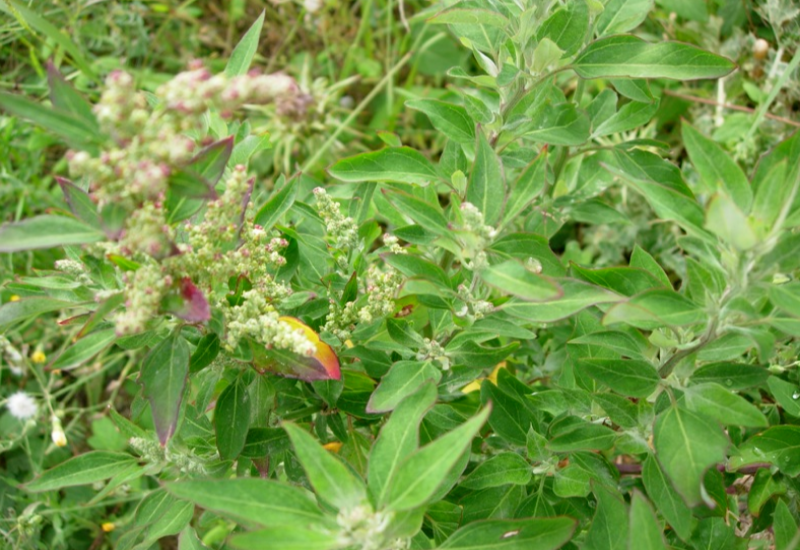
- Local Name: Lamb’s Quarter or Pigweed
- Family: Amaranthaceae
- Annual or Perennial: Annual
Lamb’s Quarter is an annual weed native to Europe and Asia that grows 1-2m tall. It has since spread to many parts of North America, including Alberta, CA.
The common garden weed tends to produce many seeds, compete for important resources, and grow faster than other vegetation. Its dense growth can also shade out other low-growing plants, leading to their death.
Remove young plants by hand-pulling or apply organic mulch to suppress their growth.
19. Sow Thistle (Sonchus arvensis)
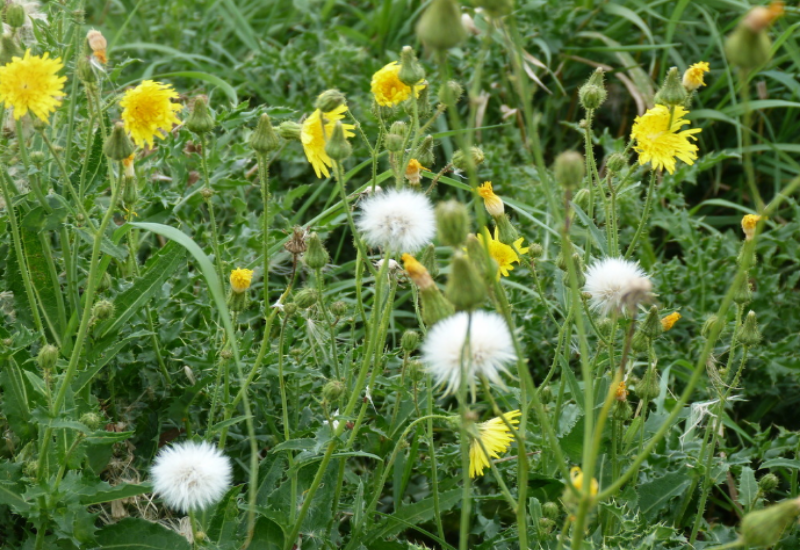
- Local Name: Mash Thistle, Field Thistle, Field Milk Thistle, or Creeping Sow Thistle
- Family: Asteraceae
- Annual or Perennial: Perennial
The perennial sow thistle is a common noxious garden weed throughout Alberta. It has long, slightly toothed leaves, yellow ray flowers, and can grow up to 1.5m tall.
The weed spreads by seeds, which sprout in mid to late May in Alberta. What makes it a noxious weed is that it grows deep underground roots, such that even small infestations can choke out other desirable plants.
Remove the young plants before they seed through digging and dispose of the fragments properly.
20. Kochia (Bassia scoparia)
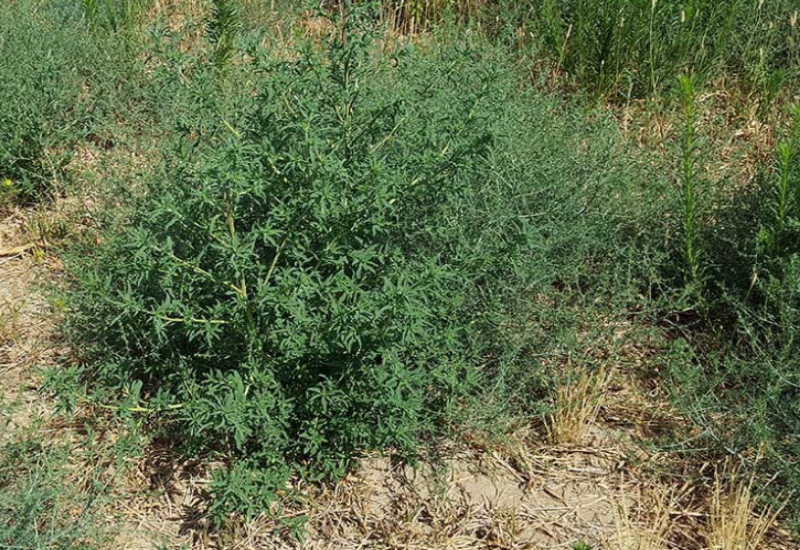
- Local Name: Tumbleweed
- Family: Amaranthaceae
- Annual or Perennial: Annual
Kochia is an Eurasian native that was introduced as an ornamental in Canada but has since become a problematic weed, especially in the arid and semi-arid regions of Alberta.
The thick bushy olive green weed grows about 4-5 feet tall. It is a prolific seed producer, resilient in dry and saline conditions, and germinates early, and grows rapidly, encouraging quick spread in gardens.
The good news is that the young plant’s shallow taproots are easy to remove through pulling or hoeing.

Lead Editor for Insight Weeds.